تأملات زیبایی شناختی در مرثیۀ ابوالعلاء (سروده ادیب بزرگ و متاخر نیجریایی محمد الغالی کبر)
DOI::
https://doi.org/10.22046/LA.2020.22کلمات کلیدی:
محمد الغالي كبرچکیده
این مطالعه به تحلیل مرثیۀ ابوالعلاء سروده شیخ محمد الغالی شاعر فقید نیجریایی میپردازد. این تحقیق با تجزیه و تحلیل صریح زیباییهای ادبی، احساسات و ظرایف کلامی در این شعر نشان میدهد شاعر محمد الغالی با وضوح و سادگی تمام و استفاده از ترکیبهای مناسب در شعرش تسلیت خود را به زبان روزمره با سبکی زیبا به دور از ابتذال بیان کرده که با سهولت و شیرینی روی لب خوانندگان جاری میشود و در عین حال از احساسات غمانگیز و اندوهبار سرشار است. با این مرثیه وی تواناییش را در استفاده از زبان برای برجسته کردن دانش خود نشان میدهد.مراجع
Sheikh Muhammad Al-Ghali: hāyiyat al-rathā lewafāt abi al-ala'
Darwish, Ahmad (1997). In Criticism of Poetry, Cairo, Dar Al-Shorouk, 1st Ed.
Ibn Rashiq Al-Omdah (1981). On the Beauties of Poetry and Its Criticism, Edited by Muhammad Mohiuddin Abdul Hamid, Dar Al-Jeel Beirut.
Al-Midani, Abu Al-Fadl Muhammad bin Ahmed Al-Nisaburi (1962). Proverbs Complex. Beirut, dar al-hayyat.
Salim, Hassan Abdel-Rahman (2006). The Art of Spinning in Mamluk Poetry, Analytical Critical Study, 1st Edition, Cairo, Literature Library.
Nasira Sawaleh (n.d.). The problem of receiving in the Sufi discourse.
Al-Shuri, Mustafa Abdel-Shafi (1997). Lamentation Poetry in Early Islam, 1st Ed, Cairo, Longman.
Zaki, Ahmed Kamal (1980). A study in modern literary criticism. 2nd Ed., Cairo.
##submission.downloads##
چاپ شده
ارجاع به مقاله
شماره
نوع مقاله
مجوز
حق نشر 2020 إسحاق أبوبكر كبر

این پروژه تحت مجوز بین المللی Creative Commons Attribution 4.0 می باشد.
فصلنامه هنر زبان یک مجله دسترسی آزاد است و مقالات پس از پذیرش در دسترس عموم قرار می گیرند و استفاده از آن با ذکر منبع آزاد است
